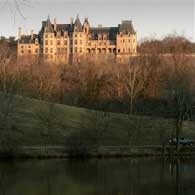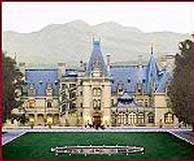ANNOUNCER:

Welcome to THIS IS AMERICA in VOA Special English. This week, Rich Kleinfeldt and Shirley Griffith are your guides as we take you to the Biltmore Estate. This huge home was built more than a century ago near the mountains of North Carolina.
VOICE ONE:
An estate is a property, usually large, owned by one person or a family. The man who owned the Biltmore estate in North Carolina was George Vanderbilt. He was born in 1862 and died in 1914. His father and grandfather were two of the richest and most powerful businessmen in America. They made their money in shipping and railroads.
When his father died, George Vanderbilt received millions of dollars. He chose to spend a good deal of that money building his home in North Carolina. More than 1,000 people began the work on it in 1889. The structure was ready six years later in December 1895. Biltmore is now open to the public. It is well worth a visit. So, close your eyes and imagine you are going there.
(MUSIC)
VOICE TWO:
Our car has just turned off one of the main roads in the city of Asheville, North Carolina. We have entered a private road that leads to the main house on the Biltmore Estate. The sides of the road are lined with trees.
When we leave the car, we walk through a wooded area. The air is clean. The trees are dark and very large. They block us from seeing anything. At last we come to an open area and turn to the right. The main house is several hundred meters in front of us.
VOICE ONE:

Biltmore is huge. It looks like a king's palace. It measures 238 meters from side to side. It is the color of milk, with maybe just a little chocolate added to make it light brown. As we walk closer, it seems to grow bigger and bigger. It has hundreds of windows. Strange stone creatures look down from the top. They seem to be guarding the house.
Two big stone lions guard the front door. Biltmore really has two front doors. The first is made of glass and black iron.
We pass through it to a second door. This one is made of rich dark wood. Both doors are several meters high. The opening is big enough for perhaps six people to walk through, side-by-side.
VOICE TWO:
A book has been written about the Biltmore estate. It includes many pictures of the house, other buildings, gardens and the Vanderbilt family. The book says the house has 250 rooms. We cannot see and count them all. Only 65 are open to the public.
One room that can be seen looks like a garden. It is alive with flowers. In the center is a statue with water running from it. When we look up, we see the sky through hundreds of windows. Eight big lights hang from the top.
Then we come to a room in which dinner can be served to many guests. The table is large enough for more than 60 people. The top of this room is more than 21 meters high. The walls are covered with cloth pictures, flags, and the heads of wild animals.
VOICE ONE:
Each room at Biltmore is more beautiful than the last. Many include paintings by famous artists, like French artist Pierre-Auguste Renoir and American artist John Singer Sargent. The chairs, beds, and other furniture were made by artists who worked in wood, leather, glass, marble, and cloth.
One room was designed for reading. It contains more than 23,000 books in eight languages. Stairs on the side of the room permit visitors to reach books that are kept near the top. The paintings in this reading room are beautiful, too.
VOICE TWO:
Later, we visit rooms below ground level. The people who worked for the Vanderbilt family lived in this lower part.
The Vanderbilts employed about 80 people to take care of the house. This included cooks, bakers, and house cleaners. Other workers took care of the many horses the Vanderbilts owned. Many of these workers lived in the main house, but some lived in the nearby town.
One of the biggest rooms below ground level is the kitchen. And there are separate rooms for keeping food fresh and cold, and for washing the Vanderbilt's clothes.
Past these rooms we find an indoor swimming pool. This area has several separate small rooms where guests could change into swimming clothes.
VOICE ONE:
We finally come back to the front door of the house. Yet there is still much to see at the Biltmore estate.
To the left of the front door, about 50 meters away, is where the Vanderbilt family kept its horses. It is no longer used for horses, however. It now has several small stores that sell gifts to visitors. Visitors can also enjoy a meal or buy cold drinks and ice cream.
VOICE TWO:
In addition to seeing the main house at Biltmore, you can walk through the gardens. Hundreds of different flowers grow there. A big stone and glass building holds young plants before they are placed in the ground outside. Past the gardens is the dark, green forest. Trees seem to grow everywhere. The place seems wild. At the same time, there is a feeling of calm order.
There was once a dairy farm on the Biltmore estate. It is gone now. The milk cows were sold. Some of the land was planted with grapes. And the cow barn was turned into a building for making wine.
VOICE ONE:
As we continue to walk, we come to an unusual house in the forest. The road on which we are walking passes through the house. The house was used many years ago by the gate keeper. Visitors traveled from this gate house to the main house. The distance between the two is almost five kilometers. The trees surrounding Biltmore look like a natural forest.
Yet all of the area was planned, built, and planted by the men who designed the estate. None of it is natural.
Now you may have begun to wonder about the history of Biltmore. Who designed it? How did they plan it? How and why was it built?
(MUSIC)
VOICE TWO:
The Biltmore estate was the idea of George Vanderbilt. The buildings were designed by Richard Morris Hunt. Mr. Hunt was one of the most famous building designers of his day. He designed and helped build several other big homes in the United States. Several of them were for other members of the Vanderbilt family. Mr. Hunt also designed the base of the Statue of Liberty in New York Harbor.
VOICE ONE:
Another famous man of the time designed the gardens at Biltmore. He was Frederick Law Olmsted. He is most famous for designing central park in New York City and the grounds around the capitol building in Washington, D.C. One of Mr. Olmsted's first projects at Biltmore was to plant and grow the millions of flowers that would be used for the gardens there.
VOICE TWO:
Another man named Gifford Pinchot was also part of the team that designed Biltmore. While there, he started the first scientifically managed forest in the United States. He cut diseased or dead trees and planted new ones. He improved the growth of many kinds of trees. It is because of his work that the wild forest at Biltmore has an ordered and peaceful look.
Gifford Pinchot left Biltmore to start the school of forestry at Yale University. Later he helped to establish the United States Forest Service.
Biltmore is surrounded by more than 1,800 hectares of forest. The forest provides a wood crop that helps pay the costs of operating the estate. It was the work begun by Gifford Pinchot that makes this possible.
(MUSIC)
VOICE ONE:
Today, Biltmore belongs to the grandchildren of George Vanderbilt. However, it is no longer used as a private home.
Many years ago, the family decided to open it to the public. Visitors help pay the cost of caring for and operating it.
Biltmore employs more than 650 people who work in the house and gardens.
The family says George Vanderbilt liked to have guests at Biltmore. They say he enjoyed showing it to others. Now, each year, about 750,000 people visit the Vanderbilt home in Asheville, North Carolina. The family says their grandfather would have liked that.
(MUSIC)
ANNOUNCER:
Our program was written by Paul Thompson and read by Rich Kleinfeldt and Shirley Griffith. I'm Faith Lapidus. Join us again next week for THIS IS AMERICA in VOA Special English.
Related stories:
A scary story to get you into the Halloween spirit
A musical history of the Rock and Roll Hall of Fame
National parks: an idea that began in the US
How we are connecting with social networks
(Source: VOA 英语点津编辑)